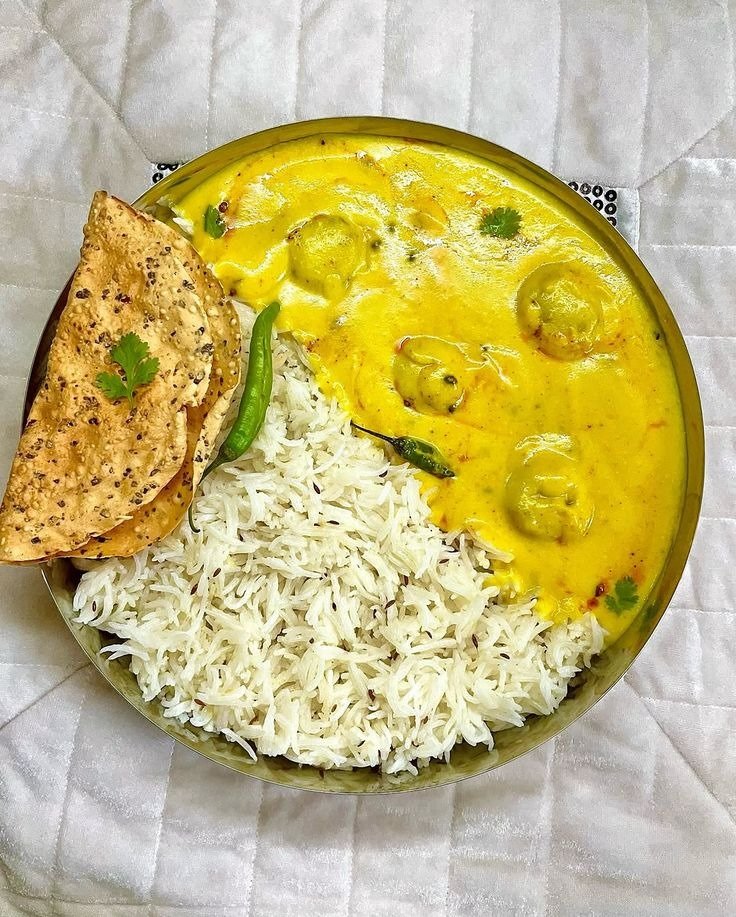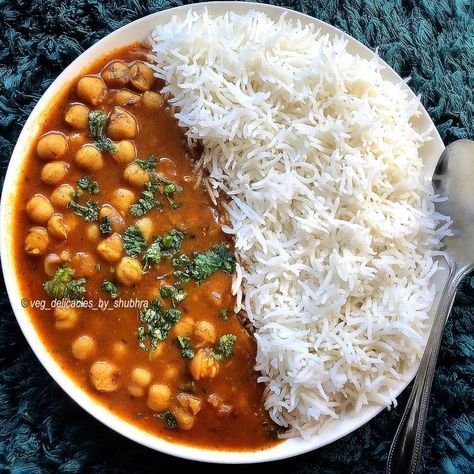
Hare krishna 🙏There are certain foods that transcend taste. They come laden with warmth, memories, and a sense of peace within. Kadhi Chawal is one of them. And when you make it satvik—without onion, garlic, or anything else that agitates the mind—it is no longer mere food, but an offering to one’s soul.
This is not a recipe, but a journey. A journey into the kitchen where the simple and the pure come together. So if you want to introduce sattva (purity and balance) in your food, or are on a spiritual journey and wish to eat accordingly, this simple yet intensely satisfying Satvik Kadhi Chawal is a great dish to start with.
What is Satvik Kadhi Chawal?
Kadhi is a curry made of yogurt and thickened by besan (gram flour), mildly spiced, and typically served with steamed rice (chawal). Kadhi chawal is comfort food in most North Indian families. However, the satvik version omits garlic, onion, and strong spices to emphasize tranquil, pure flavors.
It’s easy on the stomach, comforting to the soul, and can be presented as naivedyam (offering) during fasts or religious days.
Why to Choose Satvik Food?
Let’s hold off for a second before we dive into the recipe. Why satvik?
Satvik food is rooted in Ayurvedic eating philosophy. It is light, uncomplicated, vegetarian, and lovingly prepared with awareness. It heightens clarity, soothes the mind, and restores balance. Satvik kadhi is ideal when you’re looking for a nurturing, earthy meal that doesn’t muddle your energy or agitate your mind.
Ingredient you will need :-
Let’s start with the basic ingredients for both kadhi and chawal. All ingredients are easily available and completely vegetarian. Please use organic and fresh items if possible.
For Kadhi:
2 cups curd (preferably a bit sour, set from full-fat milk)
4 tablespoons besan (gram flour)
( want more
3.5 cups water
1 tablespoon ghee (use cow ghee for a traditional touch)
1 teaspoon cumin seeds
½ teaspoon fenugreek seeds (methi)
2 dry red chilies (optional – omit if serving as prasad)
6–7 curry leaves
½ teaspoon turmeric powder
A pinch of asafoetida (hing) – pure, wheat-free if you are gluten-free
Rock salt or sendha namak (when preparing during fasting) – else use regular salt to taste
Fresh chopped coriander for garnish
For Chawal (Steamed Rice):
1 cup basmati rice (or any good quality rice you prefer)
2–2.5 cups water
A few drops of ghee (optional)
A pinch of salt (optional)
Preparing Kadhi :– The Satvik Way
Let’s walk through each step like we’re cooking together in a small sunlit kitchen. Take your time. Breathe. Enjoy the process.
Step 1: Whisk the Base
Take your curd in a deep mixing bowl. Make sure it’s at room temperature—not cold from the fridge.
Add gram flour (besan) and whisk it very well till smooth. No lumps should be formed at all. Gradually add water and whisk.
You are looking for a thin, silky liquid. The consistency should be less than regular buttermilk.
Add turmeric and salt. Mix well. This is your kadhi base.
Step 2: Tadka (Tempering)
Heat heavy-bottomed kadhai. Put ghee. When it is hot, add cumin seeds and methi seeds. Let them splutter softly.
Add the dry red chilies (if using) and curry leaves. Take care—you can crackle them fast.
Add a pinch of hing. Mix it fast and then pour in the curd-besan mixture quickly.
Now here’s the trick: don’t hurry. Stir continuously on medium heat till it starts to boil. This prevents curdling and smoothens the texture.
As soon as it starts boiling, reduce the flame and let it simmer. Stir now and then. Simmer it for about 20–25 minutes.
The kadhi will become thick and the raw besan flavor will die out, leaving a lovely golden, aromatic curry.
Step 3: The Final Touch
Once the kadhi has the desired consistency—not watery, not too thick—switch off the heat.
Sprinkle coriander leaves that have been just chopped.
Take a pause. Let the fragrance settle. That’s peace in a bowl.
Preparing Rice – Simple & Pure
As your kadhi is stewing, let’s prepare rice.
Step 1: Wash and Soak
Take 1 cup of rice. Wash 2–3 times in fresh water. Soak for 15–20 minutes if possible. It aids in digestion and makes the grains light.
Step 2: Cook the Rice
In a pan, put 2 to 2.5 cups of water and a pinch of salt (optional). Put the soaked rice.
Boil, then reduce the heat and cover it. Let simmer until rice is tender and every grain is cooked. Do not overcook.
Add a few drops of ghee if desired—it imbues a soft fragrance and increases the satvik qualities.
How to Serve Satvik Kadhi Chawal
Presentation is as important as cooking. Serve your meal with consideration.
Use a deep bowl. Fill a ladle of warm rice. Fill with plenty of kadhi over it. Use coriander as a garnish.
To go on the side, roasted papad, a plain cucumber salad, or even a spoonful of homemade mango pickle (no garlic) may be used. A piece of jaggery or fresh fruit may also be served in addition to complete the meal.
Tips for Best Taste
Use a little bit sour curd – It gives the tang which is a must for kadhi.
Keep stirring continuously – Particularly while first boiling to prevent splitting.
Don’t use high flame – Slow cooking lets the real flavor out.
Use fresh ghee – Smell of pure cow ghee makes a difference.
Don’t add excessive spices – Keep it light, keep it peaceful.
Why This Dish is Emotionally Healing
Ever have one of those days where your thoughts are a million miles away, your body is weighed down, and your heart longs for quiet? Satvik kadhi chawal is the solution.
It’s easy on the digestive system, calms tamas (heaviness) and rajas (excitement), and lightens your mood. It’s comforting, tangy, creamy, and uncomplicated. There’s something about its flavor that feels like a hug.
Even ancient Ayurvedic literature suggests curd-based food such as kadhi for digestive equilibrium if properly cooked and served warm.
Kadhi Without Onion-Garlic :– Will It Taste Good?
Yes. And actually, most people who have tried this satvik version say it tastes cleaner, more assimilable, and calming. The secret is employing slightly sour curd, quality besan, and allowing the spices to bloom in a gentle fashion in ghee.
You don’t require heavy masalas to cook something tasty. You only require balance.
Storytime – My Memory With Kadhi Chawal
I remember to this day returning home from school on a rainy afternoon, socks soaked, bag full, and empty stomach. The minute I entered the house, that familiar scent greeted me—kadhi on the boil in the kitchen.
Ma would be slowly stirring it, and rice would already be steaming. She’d serve it hot, with a tiny steel katori of jaggery and a crunchy papad. That one bite made me forget everything.
Years later, when I make it, I still find myself 10 years old again, enveloped in warmth, sitting on the kitchen floor beside Ma.
That’s the magic of kadhi chawal.
When to Make Satvik Kadhi Chawal?
You can enjoy this dish anytime, but it’s especially perfect for:
Ekadashi or fast-breaking days (use rock salt)
Light dinners or lazy Sunday lunches
When you’re feeling low or unwell
After meditation or yoga practice
As a sattvik prasad during small pujas
Conclusion :– A Bowl Full of Balance
Satvik kadhi chawal is not just a food. It is an experience. It makes you feel connected to where you come from, calms your mind down, and feeds not only your body but your soul as well.
Let’s restore slow meals in the midst of fast food. Meals that are cooked with love, served with love, and consumed with appreciation.
The next time you are feeling overwhelmed or unbalanced, simply boil a pot of kadhi, steam some rice, sit calmly, and let the magic occur.
For sometimes, peace does come in the guise of a simple yellow curry, ladled over a soft bowl of rice.
Thank you for reading and sharing the space with me. May your kitchen be warm, your food be loved, and your heart be filled with delight.



